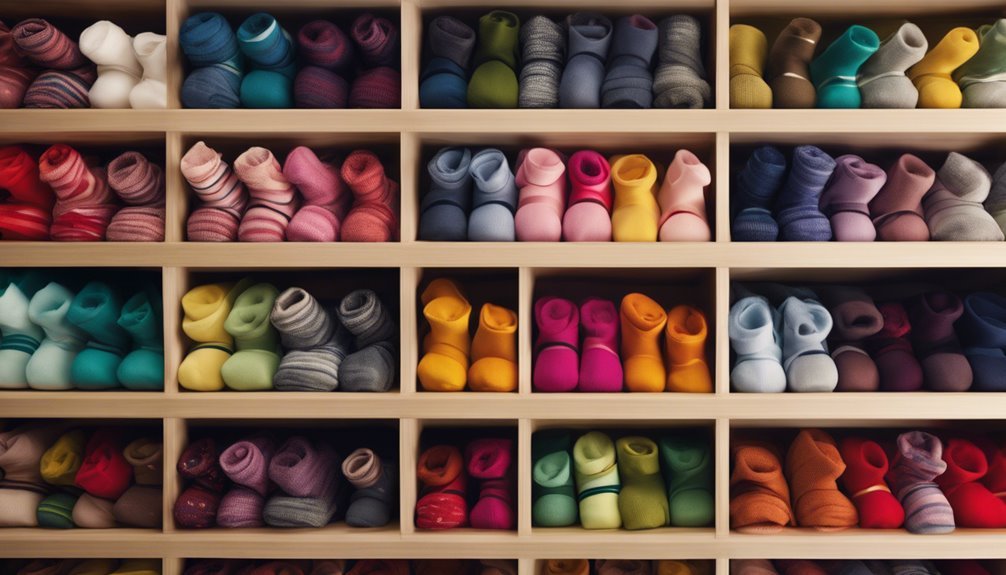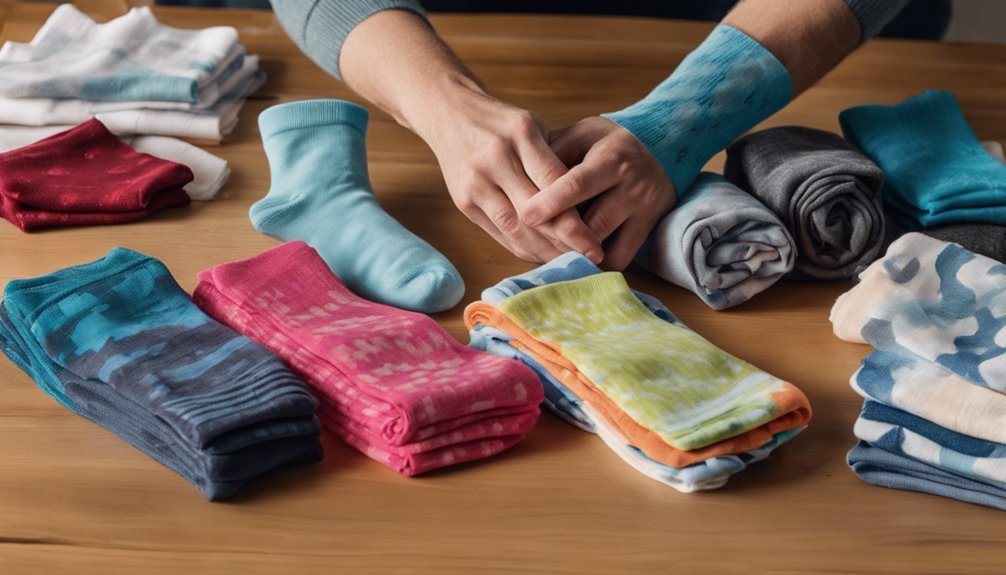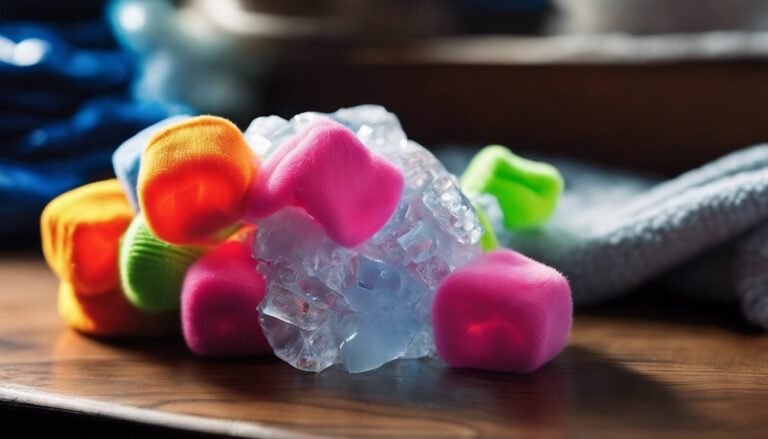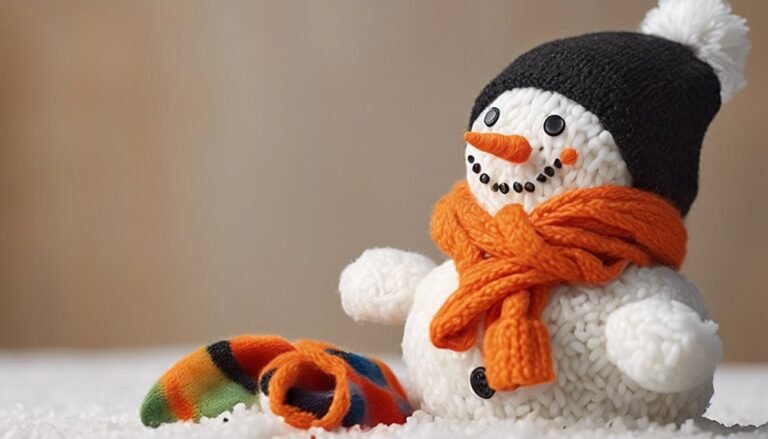How to Make Your Socks Last Longer: Simple Tricks to Prevent Wear & Tear
Have you ever noticed how quickly socks seem to wear out? To make your socks last longer, select durable materials like wool or fabric blends and ensure a proper fit to prevent wear.
Wash them with a gentle detergent in appropriate temperatures and air dry to maintain fiber integrity. Rotate pairs to distribute wear evenly and store them in a cool, dry place.
Address small holes swiftly with darning techniques. Invest in quality socks with reinforced heels and toes.
To explore further, you're on the verge of discovering additional strategies.
Choose the Right Material for Your Socks

When it comes to choosing the right material for your socks, understanding fabric properties is essential. Different sock materials offer distinct advantages. Cotton is breathable but can retain moisture, potentially leading to discomfort. Wool, on the other hand, provides excellent insulation and moisture-wicking capabilities, making it ideal for colder climates. For those seeking lightweight durability, synthetic fibers like nylon or polyester are best, offering enhanced strength and elasticity. Exploring fabric blends allows you to harness the benefits of multiple materials. For instance, a cotton-polyester blend provides softness with added resilience, while wool-nylon blends combine warmth with durability. By selecting the right materials, you can guarantee your socks meet your needs, providing comfort and freedom without compromising on longevity.
Pay Attention to Proper Sizing and Fit
Proper sizing and fit play an essential role in extending the lifespan of your socks. When socks are too tight, they can stretch beyond their elastic limit, causing premature wear. Conversely, overly loose socks may create friction, leading to fabric thinning. Understanding sock sizing is vital; it guarantees a snug fit without constriction. Pay close attention to sizing charts provided by manufacturers, often based on shoe sizes, to select the ideal fit. The fit importance goes beyond comfort, affecting the sock's integrity and longevity. Choose socks crafted with a blend of resilient materials that maintain elasticity and shape after repeated wear. By prioritizing fit, you gain the freedom to enjoy your favorite socks longer, reducing both waste and frequent replacements.
Wash Your Socks With Care

To guarantee your socks endure through countless wears, it is crucial to wash them with care, employing techniques that preserve their fibers and elasticity. Start by selecting a sock detergent specifically formulated for delicate fibers. This choice prevents harsh chemicals from breaking down the fabric's integrity. Next, adhere to washing temperature guidelines. Use cold water for cotton or wool blends to maintain elasticity and prevent shrinkage, while synthetic fibers may benefit from warm water, enhancing their resilience. Always turn your socks inside out before washing to minimize friction and maintain their vibrant colors. By applying these strategies, your socks won't just last longer—your feet will revel in the freedom of a comfortable, enduring fit.
Drying Techniques to Avoid Damage
To guarantee your socks maintain their integrity, it's essential to air dry them rather than using a machine. Excess heat from dryers can degrade fibers like elastane and wool, reducing elasticity and causing shrinkage. If you must use a dryer, select gentle cycles with low temperatures to minimize mechanical stress and thermal damage.
Air Dry Only
Although it might be tempting to toss your socks into the dryer for convenience, air drying is a superior method to prevent damage and prolong their lifespan. By allowing air circulation to naturally wick away moisture, you minimize fiber stress and maintain the elasticity of the fabric. Sock drying on a flat, well-ventilated surface promotes even drying, preventing distortion and reducing friction-related wear. For peak results, avoid direct sunlight, as UV rays can degrade material integrity over time. Hang your socks in a shaded, breezy area to facilitate gentle drying. This technique is particularly beneficial for delicate materials like wool or cashmere, which are prone to shrinkage and fiber breakdown. Embrace the freedom of air drying to keep your socks in exceptional condition.
Avoid Excess Heat
When it comes to preserving the quality of your socks, limiting exposure to excess heat is essential. High temperatures can degrade fibers, causing premature wear. To optimize sock storage and care, consider the impact of various heat sources.
- Avoid direct sunlight: Ultraviolet rays can weaken fabric integrity, fading colors and reducing elasticity.
- Steer clear of radiators: These emit dry heat that can cause shrinkage and harden delicate materials.
- Skip the high-heat dryer cycles: They increase friction, leading to pilling and thinning of the fabric.
Use Gentle Cycles
Limiting heat exposure is essential, and choosing the right drying techniques further extends the lifespan of your socks. Utilizing gentle washing and appropriate cycle settings protects the delicate fibers. Most washing machines include a gentle cycle, which employs reduced agitation to minimize stress on materials. This setting is particularly effective for socks made of cotton, wool, or synthetic blends. The gentle cycle lowers the mechanical action exerted on fabric, preventing premature wear and tear.
After washing, air drying is preferable. If machine drying is necessary, select a low-temperature setting. High heat can degrade elastic fibers, resulting in loss of shape and elasticity. By attentively managing cycle settings and avoiding excessive heat, you grant your socks the freedom to endure many wears without succumbing to damage.
Rotate Your Sock Collection Regularly
To guarantee an even distribution of wear across your sock collection, it's essential to implement a systematic rotation strategy. By regularly alternating which pairs you wear, you mitigate the concentrated stress placed on individual socks, thereby extending their overall lifespan. This approach capitalizes on the durability of the material and maintains the integrity of the fabric through consistent usage patterns.
Evenly Distribute Wear
Rotating your sock collection regularly is a strategic practice to confirm even distribution of wear, thereby extending the lifespan of each pair. Sock rotation minimizes concentrated wear patterns, which occur when you repeatedly use the same sets. By diversifying usage, each pair receives equal strain, preserving fabric integrity. Consider these tactics:
- Catalog Your Collection: Keep an inventory to confirm old pairs aren't neglected.
- Schedule Rotations: Implement a systematic schedule to rotate socks weekly.
- Material Awareness: Understand material properties; rotate based on durability.
These practices allow for more freedom in your sock choices without sacrificing quality. By managing sock rotation effectively, you empower yourself to maintain a versatile wardrobe. This attention to detail confirms you're not bound by premature sock deterioration, embracing both style and longevity.
Extend Sock Lifespan
When seeking to extend the lifespan of your socks, a key strategy involves the regular rotation of your collection. By consistently alternating your sock pairs, you prevent excessive wear on any single set, enhancing fabric durability options. This practice acts as a catalyst for sock longevity tips, distributing usage evenly and minimizing material fatigue. Opt for socks crafted from resilient fibers, such as merino wool or high-quality synthetic blends, which naturally resist abrasion. Embrace the freedom to diversify your collection, ensuring each pair experiences equal wear intervals. Regular rotation mitigates stress on fibers, thereby prolonging their structural integrity. Remember, integrating this simple yet effective approach into your routine not only safeguards your investment but also complements your dynamic lifestyle.
Store Your Socks Correctly

Proper storage of your socks can greatly extend their lifespan. A well-organized sock drawer not only makes it easier to find the perfect pair but also minimizes fabric stress. To achieve ideal sock drawer organization, categorize by usage frequency and material. For seasonal sock storage, rotate them according to climate changes. This guarantees that wool socks maintain their integrity during warmer months, while cotton socks are ready for summer comfort. Consider implementing:
- Dividers or bins: Prevent entanglement and maintain sock elasticity.
- Breathable storage bags: Protect delicate materials like silk or cashmere.
- Proper folding techniques: Avoid stretching and maintain shape by folding instead of rolling.
These methods preserve not only your socks but also offer the freedom to enjoy them longer.
Repair Small Holes Before They Worsen
While organizing your sock drawer guarantees longevity, addressing wear and tear is equally important. To prevent small holes from expanding, employ darning techniques using a yarn matching your sock's material. Insert a darning egg or a similar rounded object into the sock to maintain shape and stability. Use a darning needle to weave horizontal and vertical stitches, creating a reinforcing mesh over the hole. For larger tears, patching methods are ideal. Select a material patch similar in texture and color to your socks. Secure it with a sewing machine or hand stitch using a zigzag pattern, ensuring the patch adheres firmly. By tackling holes promptly, you're free from the constraints of frequent replacements, extending your sock's life considerably.
Invest in Quality Socks for Longer Durability
Although it might be tempting to buy cheaper socks, investing in high-quality options can greatly enhance their durability. Quality socks are crafted with advanced sock materials like merino wool, combed cotton, or synthetic blends. These materials are engineered to withstand abrasion and provide elasticity, aligning with key durability factors. A high thread count and reinforced heel and toe regions are vital for prolonging lifespan.
Consider these essential attributes:
- Fiber Composition: Opt for fibers known for moisture-wicking and resilience.
- Construction Technique: Seamless designs reduce friction, preventing premature wear.
- Reinforcement: Targeted cushioning in high-friction areas boosts longevity.
Frequently Asked Questions
How Can I Prevent Socks From Slipping Down During Wear?
Imagine socks as a kite needing the right tension to fly. Guarantee a snug sock fit by choosing those with strong elastic bands. Materials like spandex or Lycra can prevent slipping, granting you the freedom to move effortlessly.
Are There Specific Techniques to Avoid Sock Odors?
To tackle sock odors, sprinkle baking soda inside them to neutralize bacteria. Infuse essential oils, like tea tree or lavender, for antimicrobial properties. These techniques liberate your feet from unpleasant smells, ensuring your socks stay fresh longer.
What Are Effective Methods to Remove Stubborn Sock Stains?
Think of stubborn sock stains as stubborn as a mule. For effective stain removal, pre-treat with an enzyme-based detergent or white vinegar. Use cold water in your laundry routine to prevent setting, ensuring freedom from unsightly marks.
How Often Should I Replace My Sock Drawer?
You should assess your sock lifespan by examining material wear and elasticity. Regularly organize your drawer, ensuring rotation to prevent uneven usage. Replace socks showing significant thinning, holes, or loss of elasticity to maintain ideal drawer organization.
Can Certain Activities Shorten the Lifespan of Socks?
Your running habits and washing techniques can considerably affect sock longevity. High-impact activities create friction, wearing down fibers. Aggressive washing with hot water or harsh detergents weakens material integrity, leading to faster degradation. Choose gentle methods for freedom.







